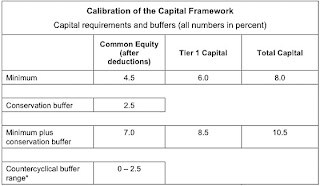Fundamentally, the new standards will considerably strengthen the reserve requirements, both by increasing the reserve ratios and by tightening the definition of what constitutes capital. It will more than triple the amount of capital that banks must hold in reserve to absorb losses, in order to force them to maintain a larger cushion against potential losses.

The proposals increase the common equity reserve (or Core Tier 1 capital, calculated as a percentage of risk-weighted assets), the least risky form of capital, from 2% to 7% of their risk-weighted assets. Add in a 2.5% conservation buffer, banks will need 7% common equity, 8.5% Tier 1 capital, and 10.5% Tier 2 capital reserve. Further, there is also a counter-cyclical buffer of 0-2.5%, to be set by individual national regulators, which accounts for any irrational exuberance during the good times. This means a potential loss-absorbing capital requirement of upto 9.5% common equity, 11% Tier 1 capital, and 13% Tier 2 capital.
The new norms also introduce a Tier 1 leverage ratio of 3%, which would limit banks to lending 33 times their capital, which represents a cap on bank risk irrespective of the impact from the higher capital numbers. Though this ratio, intended as a backstop to the risk-based measures, is targeted to be achieved only by 2018, the banks will need to disclose their leverage ratios from 2015.
However, as the timetable below shows, banks have been provided a lengthy transition period, nearly a decade, to adjust to these tougher norms. Some of the provisions do not take full effect until the beginning of 2019, so as to comply with some of the strictest rules. January 1, 2013, has been set as the deadline for member nations to begin to phase in Basel III rules.

Mark Thoma has this nice analysis of the the new norms. Simon Johnson advocates the Hanson-Kashyap-Stein view that banks should be required to hold enough capital at the peak of the cycle so that when they suffer losses they still have enough capital (and are not forced into distress sales) so that the markets do not think they will fail. This points toward at least 15 percent Tier 1 capital being required in good times; the most forward-looking officials in Group of 20 countries may aim for closer to 20 percent.
Update 1 (18/9/2010)
Felix Salmon writes that Basel III does "a bad job of reducing unforeseeable risks", with the result that "banks are incentivized to load up on the kind of securities which can blow up in unforeseeable ways". And one of the ways in which it causes this is by continuing up the possibility of gaming risk measures. Like Basel II, the proposed arrangement too leaves risk measurements to the discretion of individual banks. As Noah Millman writes, "Since taking any additional measurable risk is now stigmatized, the game becomes how to increase returns without increasing measurable risk".
Update 2 (19/9/2010)
Economist points to analysis by Credit Suisse which shows that all but the shakiest European banks will meet these requirements by 2012, with many of them already meeting them.

No comments:
Post a Comment